|
The purpose of the present report is analyzes and generalizations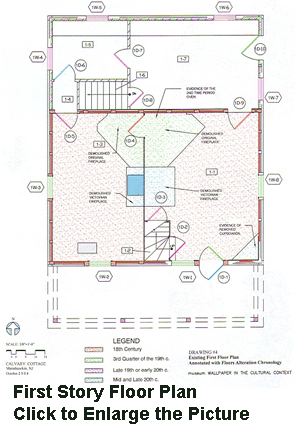 of the
architectural history of the of the
architectural history of the
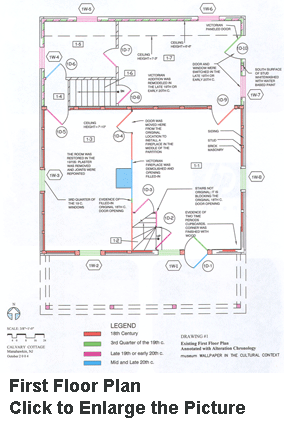 Cavalry Cottage (Manahawkin, NJ). The report is based on the physical investigation of the building performed in October of 2004. The provided information is new and does not duplicate previous studies and/or historical reports. A selected bibliographical list of referenced sources is located at the end of the report. The discovered material cannot support the entire building restoration, but can be used for a historical analyzes and for planning future preservation work. Cavalry Cottage (Manahawkin, NJ). The report is based on the physical investigation of the building performed in October of 2004. The provided information is new and does not duplicate previous studies and/or historical reports. A selected bibliographical list of referenced sources is located at the end of the report. The discovered material cannot support the entire building restoration, but can be used for a historical analyzes and for planning future preservation work.
The Cavalry Cottage is extremely important for both the local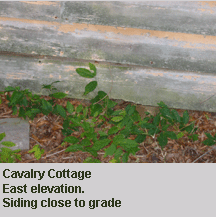 community and national history. An community and national history. An
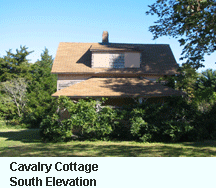 extensive physical historical investigation is a necessary first step in developing the substantiated restoration and adaptive reuse projects. Unfortunately, limited time did not allow the completion of the full spectrum of comprehensive research. However, it was possible to provide the main portion of information that resulted in a better understanding of the historical, methodological and structural problems, to create a general strategy and to develop recommendations for the conservation and adaptive reuse projects based on reliable information. Further research can be done in the future for the entire building and its parts and details. All field investigations should be performed under extreme care in order not to damage the building’s historical fabric. extensive physical historical investigation is a necessary first step in developing the substantiated restoration and adaptive reuse projects. Unfortunately, limited time did not allow the completion of the full spectrum of comprehensive research. However, it was possible to provide the main portion of information that resulted in a better understanding of the historical, methodological and structural problems, to create a general strategy and to develop recommendations for the conservation and adaptive reuse projects based on reliable information. Further research can be done in the future for the entire building and its parts and details. All field investigations should be performed under extreme care in order not to damage the building’s historical fabric.
The Cavalry Cottage is located on the
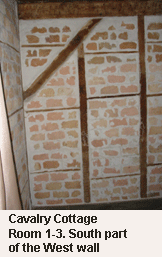 North side of Stafford Avenue, west of the Methodist church. At the North side of Stafford Avenue, west of the Methodist church. At the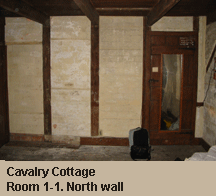 present time the house appears to have a rectangular plan. The 2-story building has a gabled roof, a porch on the South side and an addition on the North side. Exteriors are finished with a bevel type siding
. The simple rectangular shaped dormer is finished with shingles. The location of the brick chimney on the top of the roof is evidence that the oven (or chimney) was last located in the middle of the Main part of the house. The North and West foundation walls of the house are made of stone. The siding of the East elevation is touching the ground, which indicates that the foundation wall there is entirely buried. The South porch is decorated with simple brackets below the cornice. The building’s wall structures are seen through the gaps between the porch roof and the house siding. A well projected roof overhang of East and West facades might have preserved the original siding with the traces of the original exterior paint. present time the house appears to have a rectangular plan. The 2-story building has a gabled roof, a porch on the South side and an addition on the North side. Exteriors are finished with a bevel type siding
. The simple rectangular shaped dormer is finished with shingles. The location of the brick chimney on the top of the roof is evidence that the oven (or chimney) was last located in the middle of the Main part of the house. The North and West foundation walls of the house are made of stone. The siding of the East elevation is touching the ground, which indicates that the foundation wall there is entirely buried. The South porch is decorated with simple brackets below the cornice. The building’s wall structures are seen through the gaps between the porch roof and the house siding. A well projected roof overhang of East and West facades might have preserved the original siding with the traces of the original exterior paint.
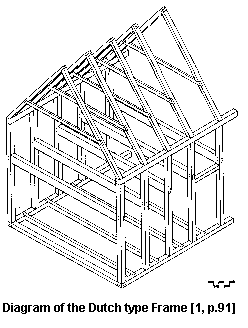

The frame structures of the North and South walls are different from West and East wall. North and South walls have studs 6” in width. These studs are 12’ tall and they are continues up to the 2nd floor. The West and East walls have studs 3” in width, which serve only first floor space. The height of them is 8’ and the top horizontal member of the frame is visible in the interior of these rooms.

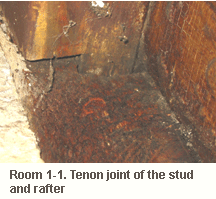 The first floor interior space contains two areas: original at the South side, which can be dated by the 18th century and at the North the 19th century addition. The original two-story portion is a wooden frame filled with brick masonry. The siding suggests that it was installed initially as an enhancing part of the structure and as a protection against weathering. The first floor interior space contains two areas: original at the South side, which can be dated by the 18th century and at the North the 19th century addition. The original two-story portion is a wooden frame filled with brick masonry. The siding suggests that it was installed initially as an enhancing part of the structure and as a protection against weathering.
The first floor of the South space is divided into two rooms with 1” thin partition erected with vertically oriented profiled boards. The ceiling height of the first floor rooms in this area is 7’-10”.
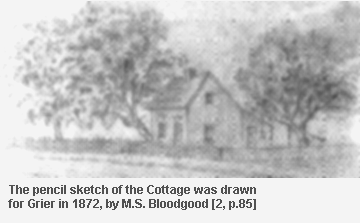 The first floor of the North space is shown as an addition on the 1872 drawing and can be dated by the third quarter of the 19th century. In a future research this date has to be updated: the North part of the building could have been erected as a shed in the 18th century together with the original South part of the house. The door and window on the East elevation have a different location compared to the 1872 drawing: their places were switched. Two hypotheses could be suggested: The first floor of the North space is shown as an addition on the 1872 drawing and can be dated by the third quarter of the 19th century. In a future research this date has to be updated: the North part of the building could have been erected as a shed in the 18th century together with the original South part of the house. The door and window on the East elevation have a different location compared to the 1872 drawing: their places were switched. Two hypotheses could be suggested:
· The addition was demolished and erected again and
· The addition was remodeled in the late 19th or early 20th century.
A whitewashed door jamb (photographs 4, 5) found between the existing door and window is the evidence of the 2nd hypothesis. The ceiling height in the North addition is 7’-3”.
The second floor originally did not have a partition, which is currently dividing the space into Eastern and Western parts. The South and North exterior walls have a frame structure and they are a continuation of the first floor structural elements: a wooden frame filled with brick masonry. The ceiling height of the second floor rooms is 7’-3”.
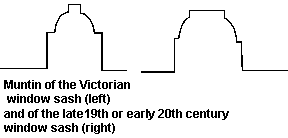
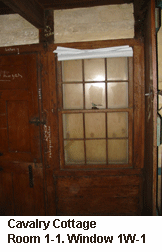 None of the original
window sash remains in the house. The original 18th century windows were replaced in the third quarter of the 19th century. Double sashes 6 over 6 were installed at that time . The next time period contributed a different type of sash with four glass panels. The window muntins of both time periods are shown on the Illustration
above. None of the original
window sash remains in the house. The original 18th century windows were replaced in the third quarter of the 19th century. Double sashes 6 over 6 were installed at that time . The next time period contributed a different type of sash with four glass panels. The window muntins of both time periods are shown on the Illustration
above.
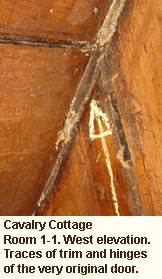
The doors in the house are presented by several time periods. It is quite possible that very original ledged doors still remain in the interiors.
Two paneled doors were obviously made during Victorian age. Another type of the Victorian ledged doors are presented by the stair doors. The other doors in the house (in the North addition and on the 2nd floor) were installed in the very late 19th or 20th century. The very original door opening was discovered in the middle of the partition between rooms 1-1 and 1-3 . After relocation of the fireplace from the corner to the middle of the room, the original door was moved to the North part of the wall.
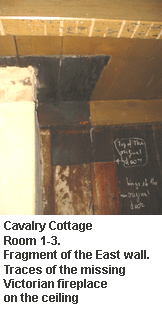
The evidence of the diagonal in plan fireplaces was discovered in
the Northwest corner of room 1-1 (kitchen) and Northeast corner of room
1-3 (bedroom). Traces of them can be seen in the floo and in the ceiling. After their demolition (probably in the third quarter of the 19th century) another fireplace was installed in two rooms of the first floor. This time they were located in the middle of the rooms and had a rectangular shape in plan with rounded corners. They were demolished, probably in the mid of the 20th century. Their traces are seen in both rooms on the walls, ceilings and floors. Foundation structures of both fireplaces are visible under the floor.
There are multiple traces of previous hardware on the doors. It means
the almost all original hardware was replaced. Four types of previous hinges were found on some of the doors. One of the tasks of the future research is to determine the type, sizes and location of the original hardware for each door.
The house has two stairs. The stair in room 1-1 can be considered as a Main stair. It is not original since it covers the original door, which was located in the middle of the wooden partition. A painted wall and door trim are visible between the wall and the stair structures.
Another stair is located in the North addition and leads to the basement. This simple stair was probably made t together with the addition and the basement, i.e. in the Victorian time.
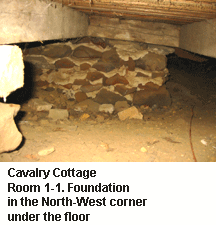
The floors in the original part of the house, made of pine, have a number of patches. Most of them are in location of the original fireplaces. One of them (in the South-East corner of the room 1-1) is a place of a removed corner built-in cupboard.
The ceilings of the first floor of the original part of the house appeared as bead boards nailed to the 3”x6.5” rafters. The traces of the fireplaces, cupboard and a patch of chimney are visible on the ceiling surface in both initial South rooms.
Recommended Additional research shall be done before the restoration work.
To be determined:
• The date of each functional, structural and decorative element
• The possible existence of a oven in the North-West corner in room 1-1
• Sizes and locations of the original ladder to the 2nd floor in room 1-1
• Date, shape, material and sizes of door hardware for each time period
• Original location of each door leaf
• Original location of the windows and entrance doors on the South and East elevations
• Date of the North addition
• Paint analyzes of all interior and exterior elements.
• It would be extremely helpful to verify some of the dates, such as the erection of the house and the time period when general Grier lived there. Local municipal archives may provide valuable information
• The full set of the archeological work around the house cannot be justified. However, two locations are fit for the local digging:
1. Digging at the East or West exterior walls at the place where the main part of the building and shed meet will help determining if they were built simultaneously or not; the original grade level for each time period can be discovered as well.
2. The siding of the East elevation touches the ground, which causes a technical problem. Digging in the South part of the East wall can determine the original grade level, to which the hidden foundation wall can be excavated to open the historical fabric and prevent rotting of the wooden structural elements.
The Preservation philosophy has to be based on the national and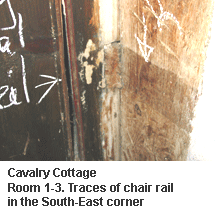 international standards and practical experience international standards and practical experience
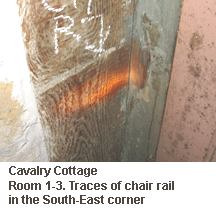 with considerations of the local conditions related to the particular monument. The upcoming
preservation work on the Cavalry Cottage may be defined as a general conservation with fragmentary restoration.
Conservation in this case means structural reinforcement, prevention of destruction and maintainence on a permanent basis. It relates to all structural and decorative elements of the building. Fragmentary restoration is applicable to the building’s very minor details, and has a goal to preserve and emphasize their historic and aesthetic values. For instance, one of the original doors could be restored completely to give the idea of its initial appearance. with considerations of the local conditions related to the particular monument. The upcoming
preservation work on the Cavalry Cottage may be defined as a general conservation with fragmentary restoration.
Conservation in this case means structural reinforcement, prevention of destruction and maintainence on a permanent basis. It relates to all structural and decorative elements of the building. Fragmentary restoration is applicable to the building’s very minor details, and has a goal to preserve and emphasize their historic and aesthetic values. For instance, one of the original doors could be restored completely to give the idea of its initial appearance.
The building has a double significance. 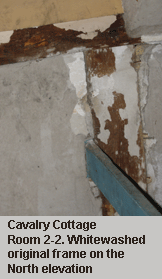
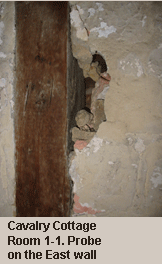 1. It is an architectural monument built in the 18th century, which has a great importance as a representative of the history of early American architecture. 1. It is an architectural monument built in the 18th century, which has a great importance as a representative of the history of early American architecture.
2. It has high memorial significance. General Grier lived there from 1872. It means the building modifications done at the memorial time period are important and shall be presented, interpreted and exposed.
Plumbing of the mid of the 20th century and later and related work (toilet room, piping, etc.) can be considered as insignificant.
Restoration of the 1970s should be left for different reasons.
• The original structures were exposed during that restoration.
• Removed plaster should not be replicated even if the future in depth research discovers that it was done by General Grier. The evidence of the plaster is obviously exposed on the wooden structures of the exterior walls.
• The 1970s work can be considered as a first attempt of restoration and historic interpretation and is a part of the spiritual history of the house.
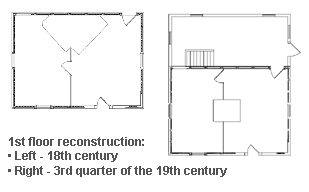 The base statements and recommendations for the preservation works of the Cavalry Cottage. The base statements and recommendations for the preservation works of the Cavalry Cottage.
• The memorial period that is significant for the Cavalry Cottage is between the 18th century (erection) and the late 19th century, when general Grier lived there. It means everything within this time frame including the additions and alterations, has to be preserved and maintained. The House with the entire set of alterations can be used to study the American architectural history .
• Application of new technology has to be verified by decades of successful use. New materials used during preservation works have to be compatible with the existing ones.
• New elements added as a part of the adaptive reuse must be distinguishable from the historic fabric. At the same time they have to be aesthetically neutral in relationship to the initial parts and finishes.
• It is unacceptable removing any contribution to the building dated by the time period important for building’s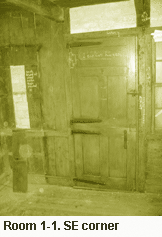 history. Even stripping old paint layers from the historical woodwork cannot be recommended because valuable information may be lost. These layers are subject for opening and exposing to illustrate the finished history of the details of the building. history. Even stripping old paint layers from the historical woodwork cannot be recommended because valuable information may be lost. These layers are subject for opening and exposing to illustrate the finished history of the details of the building.
• Too intensive use for any local needs with easy public access cannot be recommended, though the building should not be used for exclusively museum exposition either. For instance, a souvenir or antique shop, or a bookstore could be established in the two original rooms at the first floor .
• The future project can include interior elevations drawings with reconstruction for each significant time period and recommendations for restoration work.
• The original details have to remain in place as much as their technical condition allows. Repairing work is preferable to replacement.
Igor Kiselev October 2004
Selected BIBLIOGRAPHY
1. Everyday Architecture of the Mid-Atlantic. By Gabrielle M. Lanier and Bernard L. Herman. The Johns Hopkins University Press. Baltimore and London. 1997
2. Stafford Chronicles. Down the Shore Publishing. Harvey Cedars, NJ, 2001
3. The Secretary of the Interiors. Standards for Historic Preservation
Projects. Developed by W. Brown Morton III and Gary L. Hume. Washington, D.C. 1979.
4. The Venice Charter. INTERNATIONAL CHARTER FOR THE CONSERVATION AND RESTORATION OF MONUMENTS AND SITES.
Congress of Architects and Technicians of Historic Monuments, which met in Venice from May 25th
to 31st, 1964
|

![]()